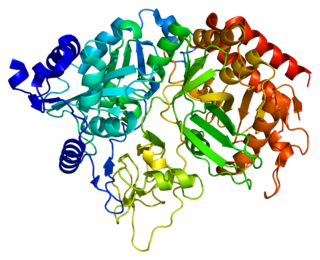Calpain-10 is a protein that in humans is encoded by the CAPN10 gene. [5] [6]
Calpain-10 is a protein that in humans is encoded by the CAPN10 gene. [5] [6]
Calpains are ubiquitous, well-conserved family of calcium-dependent, cysteine proteases. The typical calpain proteins are heterodimers consisting of an invariant small subunit and variable large subunits. The large catalytic subunit has four domains: domain I, the N-terminal regulatory domain that is processed upon calpain activation; domain II, the protease domain; domain III, a linker domain of unknown function; and domain IV, the calmodulin-like calcium-binding domain. The heterodimer interface is predominantly found between domain IV and the small subunit, which is also a calmodulin-like calcium-binding domain. This gene encodes a large subunit. It is an atypical calpain in that it lacks the calmodulin-like calcium-binding domain and instead has a divergent C-terminal domain. It therefore cannot heterodimerize with the small subunit. It is similar in organization to calpains 5 and 6. This gene is associated with type 2 or non-insulin-dependent diabetes mellitus (NIDDM) and located within the NIDDM1 region. Multiple alternative transcript variants encoding different isoforms have been described for this gene. [7]

Corticosteroid 11-β-dehydrogenase isozyme 2 also known as 11-β-hydroxysteroid dehydrogenase 2 is an enzyme that in humans is encoded by the HSD11B2 gene.

Homeobox expressed in ES cells 1, also known as homeobox protein ANF, is a homeobox protein that in humans is encoded by the HESX1 gene.

Gonadotropin-releasing hormone receptor is a protein that in humans is encoded by the GNRHR gene.

The human gene SRD5A2 encodes the 3-oxo-5α-steroid 4-dehydrogenase 2 enzyme, also known as 5α-reductase type 2 (5αR2), one of three isozymes of 5α-reductase.

Fatty acid-binding protein 2 (FABP2), also known as Intestinal-type fatty acid-binding protein (I-FABP), is a protein that in humans is encoded by the FABP2 gene.

HNF1 homeobox B, also known as HNF1B or transcription factor 2 (TCF2), is a human gene.

HSD3B2 is a human gene that encodes for 3beta-hydroxysteroid dehydrogenase/delta(5)-delta(4)isomerase type II or hydroxy-delta-5-steroid dehydrogenase, 3 beta- and steroid delta-isomerase 2. It is expressed principally in steroidogenic tissues and is essential for steroid hormone production. A notable exception is the placenta, where HSD3B1 is critical for progesterone production by this tissue.

Somatostatin receptor type 5 is a protein that in humans is encoded by the SSTR5 gene.

Follitropin subunit beta also known as follicle-stimulating hormone beta subunit (FSH-B) is a protein that in humans is encoded by the FSHB gene. Alternative splicing results in two transcript variants encoding the same protein.

Homeobox protein prophet of PIT-1 is a protein that in humans is encoded by the PROP1 gene.

Serum paraoxonase/arylesterase 2 is an enzyme that in humans is encoded by the PON2 gene.

Phosphorylase b kinase regulatory subunit alpha, liver isoform is an enzyme that in humans is encoded by the PHKA2 gene.

Chloride channel accessory 1 is a protein that in humans is encoded by the CLCA1 gene.

Phosphoenolpyruvate carboxykinase 1 (soluble), also known as PCK1, is an enzyme which in humans is encoded by the PCK1 gene.

Chloride channel 7 alpha subunit also known as H+/Cl− exchange transporter 7 is a protein that in humans is encoded by the CLCN7 gene. In melanocytic cells this gene is regulated by the Microphthalmia-associated transcription factor.

Protein phosphatase 1 regulatory subunit 3A is an enzyme that in humans is encoded by the PPP1R3A gene.

Solute carrier family 2, facilitated glucose transporter member 10 is a protein that in humans is encoded by the SLC2A10 gene.

Calpain-5 is a protein that in humans is encoded by the CAPN5 gene.

Cell death activator CIDE-A is a protein that in humans is encoded by the CIDEA gene. Cidea is an essential transcriptional coactivator regulating mammary gland secretion of milk lipids.

Thyroid stimulating hormone, beta also known as TSHB is a protein which in humans is encoded by the TSHB gene.